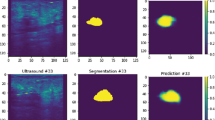Abstract
When developing deep neural networks for segmenting intraoperative ultrasound images, several practical issues are encountered frequently, such as the presence of ultrasound frames that do not contain regions of interest and the high variance in ground-truth labels. In this study, we evaluate the utility of a pre-screening classification network prior to the segmentation network. Experimental results demonstrate that such a classifier, minimising frame classification errors, was able to directly impact the number of false positive and false negative frames. Importantly, the segmentation accuracy on the classifier-selected frames, that would be segmented, remains comparable to or better than those from standalone segmentation networks. Interestingly, the efficacy of the pre-screening classifier was affected by the sampling methods for training labels from multiple observers, a seemingly independent problem. We show experimentally that a previously proposed approach, combining random sampling and consensus labels, may need to be adapted to perform well in our application. Furthermore, this work aims to share practical experience in developing a machine learning application that assists highly variable interventional imaging for prostate cancer patients, to present robust and reproducible open-source implementations, and to report a set of comprehensive results and analysis comparing these practical, yet important, options in a real-world clinical application.
L. F. Chalcroft, J. Qu, S. A. Martin, I. J. M. B. Gayo, G. V. Minore, I. R. D. Singh—Contributed equally.
Access this chapter
Tax calculation will be finalised at checkout
Purchases are for personal use only
Similar content being viewed by others
References
Anas, E.M.A., Mousavi, P., Abolmaesumi, P.: A deep learning approach for real time prostate segmentation in freehand ultrasound guided biopsy. Med. Image Anal. 48, 107–116 (2018). https://doi.org/10.1016/j.media.2018.05.010
Ghose, S., Oliver, A., et al.: A survey of prostate segmentation methodologies in ultrasound, magnetic resonance and computed tomography images. Comput. Meth. Programs Biomed. 108(1), 262–287 (2012). https://doi.org/10.1016/j.cmpb.2012.04.006
Giordano, D., Kavasidis, I., et al.: Rejecting false positives in video object segmentation. In: Azzopardi, G., Petkov, N. (eds.) Computer Analysis of Images and Patterns, pp. 100–112. Springer International Publishing, Cham (2015). https://doi.org/10.1007/978-3-319-23192-1_9
He, K., Zhang, X., et al.: Deep residual learning for image recognition (2015)
Hossain, M.S., Paplinski, A.P., Betts, J.M.: Prostate segmentation from ultrasound images using residual fully convolutional network (2019)
Kingma, D.P., Ba, J.: Adam: a method for stochastic optimization (2017)
Lei, Y., Tian, S., et al.: Ultrasound prostate segmentation based on multidirectional deeply supervised v-net. Med. Phys. 46(7), 3194–3206 (2019). https://doi.org/10.1002/mp.13577
Orlando, N., Gillies, D.J., et al.: Automatic prostate segmentation using deep learning on clinically diverse 3D transrectal ultrasound images. Med. Phys. 47(6), 2413–2426 (2020). https://doi.org/10.1002/mp.14134
Ronneberger, O., Fischer, P., Brox, T.: U-net: convolutional networks for biomedical image segmentation. CoRR abs/1505.04597 (2015). http://arxiv.org/abs/1505.04597
Rottmann, M., Maag, K., Chan, R., Hüger, F., Schlicht, P., Gottschalk, H.: Detection of false positive and false negative samples in semantic segmentation (2019)
Sarkar, S., Das, S.: A review of imaging methods for prostate cancer detection. Biomed. Eng. Comput. Biol. 7s1, BECB–S34255 (2016). https://doi.org/10.4137/becb.s34255
Sudre, C.H., Anson, B.G., et al.: Let’s agree to disagree: learning highly debatable multirater labelling. CoRR abs/1909.01891 (2019). http://arxiv.org/abs/1909.01891
Sudre, C.H., Li, W., Vercauteren, T., Ourselin, S., Jorge Cardoso, M.: Generalised dice overlap as a deep learning loss function for highly unbalanced segmentations. In: Cardoso, M., et al. (eds.) Deep Learning in Medical Image Analysis and Multimodal Learning for Clinical Decision Support. DLMIA 2017, ML-CDS 2017. Lecture Notes in Computer Science, pp. 240–248 (2017). https://doi.org/10.1007/978-3-319-67558-9_28
Wang, Y., et al.: Deep attentional features for prostate segmentation in ultrasound. In: Frangi, A.F., Schnabel, J.A., Davatzikos, C., Alberola-López, C., Fichtinger, G. (eds.) MICCAI 2018. LNCS, vol. 11073, pp. 523–530. Springer, Cham (2018). https://doi.org/10.1007/978-3-030-00937-3_60
Xie, S., Girshick, R., Dollár, P., Tu, Z., He, K.: Aggregated residual transformations for deep neural networks (2017)
Acknowledgement
This work is supported by the EPSRC-funded UCL Centre for Doctoral Training in Intelligent, Integrated Imaging in Healthcare (i4health) (EP/S021930/1) and the Department of Health’s NIHR-funded Biomedical Research Centre at University College London Hospitals. Z.M.C. Baum is supported by the Natural Sciences and Engineering Research Council of Canada Postgraduate Scholarships-Doctoral Program, and the University College London Overseas and Graduate Research Scholarships. This work is also supported by the Wellcome/EPSRC Centre for Interventional and Surgical Sciences (203145Z/16/Z).
Author information
Authors and Affiliations
Corresponding author
Editor information
Editors and Affiliations
Rights and permissions
Copyright information
© 2021 Springer Nature Switzerland AG
About this paper
Cite this paper
Chalcroft, L.F. et al. (2021). Development and Evaluation of Intraoperative Ultrasound Segmentation with Negative Image Frames and Multiple Observer Labels. In: Noble, J.A., Aylward, S., Grimwood, A., Min, Z., Lee, SL., Hu, Y. (eds) Simplifying Medical Ultrasound. ASMUS 2021. Lecture Notes in Computer Science(), vol 12967. Springer, Cham. https://doi.org/10.1007/978-3-030-87583-1_3
Download citation
DOI: https://doi.org/10.1007/978-3-030-87583-1_3
Published:
Publisher Name: Springer, Cham
Print ISBN: 978-3-030-87582-4
Online ISBN: 978-3-030-87583-1
eBook Packages: Computer ScienceComputer Science (R0)





